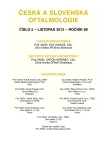The Relations of Morphological and Functional Changes in Children with Retinal Dystrophy Disease
Authors:
M. Porubanová; A. Gerinec; B. Bušányová
Authors‘ workplace:
Klinika detskej oftalmológie LFUK DFNsP Bratislava, prednosta prof. MUDr. Anton Gerinec, CSc.
Published in:
Čes. a slov. Oftal., 69, 2013, No. 5, p. 208-212
Category:
Case Report
Overview
Purpose:
To characterize the correlation between functional and morphological changes in the retina in the retinal dystrophies in children.
Methods:
In the group of six patients with selected types of retinal dystrophies was analysed the morphological findings obtained by the Optical coherence tomography (OCT) and their correlation with the electrophysiological findings.
Results:
Typical morphological retinal changes visualised by OCT were confirmed in all examined patients and were in correlation with progressive loss of visual function (decrease of visual acuity, constriction of visual field or scotomas in visual field, colour vision defect, nyctalopia) and abnormal values of the electrophysiological findings.
Conclusion:
Optical coherence tomography and electrophysiological methods are essential in approaching patient with tapetoretinal dystrophies. Correlation of these findings enables us to make diagnose easier, to understand better the dynamic of the morfological and functional changes in these patients. It can also be implicated as prognostic indicators for visual progression in patients with retinal dystrophy and also in prevention by means of genetic methods.
Key words:
optical coherence tomography, electroretinography, electrooculography, correlation, retinal dystrophies, children
Sources
1. Deutman A. F., Rumke A. M.: Reticular dystrophy of the retinal pigment epithelium, Arch Ophthalmol, 82; 1969, 1 : 4–9.
2. Fishman GA, Stone EM, Grover S, Derlacki DJ, Haines HL, Hockey RR:Variation of Clinical Expression in Patients with Stargardt dystrophy and Sequence Variation in the ABCR gene. Arch Ophthalmol, 117; 1999, 4 : 504–510.
3. Gerinec A.: Detská oftalmológia, Osveta, Martin, 2005, 592 s.
4. Hashem HA, Salaheldine MM, Karawya SS, Kamal HF: Optical Coherence Tomography Study of Typical and Atypical Cases of Retinitis Pigmentosa, J Amer Sci, 6; 2010, 10 : 1230–1236.
5. Heckenlively JR, Arden GB: Principles and Practice of Clinical Electrophysiology of Vision 2nd ed., MIT press, London, 2006, 977 s.
6. Kousal B., Skalická P., Diblík P., Kuthan P., Langrová H., Lišková P.: Klinické nálezy u členů české rodiny s retinitis pigmentosa podmíněnou mutací v ORF15 genu RPGR, Čes a Slov Oftal, 69; 2013, 1 : 8–15.
7. Lim J.I, Tan O.Huang D. et al.: A pilot study of Forier-Domain Optical Coherence Tomography of Retinal Dystrophy Patients. Amer J Ophthalmol, 146; 2008, 3 : 417–426.
8. Meredith S.P., Reddy M.A., Allen L.E. et al.: Full-field ERG responses recorded with skin electrodes in paediatric patients with retinal dystrophy. Doc Ophthalm, 109, 2004 : 57–66.
9. Musarella M.A.: Molecular genetics of macular degeneration. Doc Ophthalmol, 102; 2001, 3 : 165–177.
10. Sandberg MA, Brockhurst RJ, Gaudio AR, Berson EL.: The Association between Visual Acuity and Central Retinal Tickness in Retinitis Pigmentosa. Invest. Ophthalmol Vis Sci Sep, 46; 2005, 9 : 3349–54.
11. Schuman J.S., Puliafito C. A., Fujimoto J.G.: Optical Coherence Tomography of Ocular Diseases, Second edition, SLACK Incorporated, Thorofare, 2004, 714 s.
12. Souied E., Kaplan J., Coscas G., Soubrane G.: Macular dystrophies, J Fr Ophthalmol, 26; 2003, 7 : 743–762.
13. Štetinová T., Gerinec A.: Diagnostika tapetoretinálnych dystrofii pomocou elektrofyziologických vyšetrovacích metód, Čes a Slov Oftal, 66; 2010, 4 : 159–164.
14. Witkin A.J, Ko T.H, Fujimoto J.G et al.: Ultra-high Resolution Optical Coherence Tomography, Assessment of Photoreceptors in Retinitis Pigmentosa and Related Diseases, Am J Ophthalmol, 142; 2006 : 945–952.
15. Zahid S, Jayasundera T, Heckenlively JR: Clinical Phenotypes and Prognostic Full - field Electroretinographic Findings in Stargardt Disease, J Ophthalmol, 155; 2013 : 465–473.
Labels
OphthalmologyArticle was published in
Czech and Slovak Ophthalmology

2013 Issue 5
Most read in this issue
- Conservative Management Options for Thyroid Disease Induced Diplopia
- Management of Uncontrolled Secondary Glaucoma with ExPRESS Glaucoma Minishunt Implantation
- The Relations of Morphological and Functional Changes in Children with Retinal Dystrophy Disease
- Development of Number of Endothelial Cells after Cataract Surgery Performed by Femtolaser in Comparsion to Conventional Phacoemulsification
